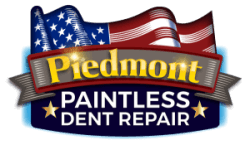When your vehicle is faced with dents that require repainting, a pressing concern is often about how well the new paint will match the original. The idea of your vehicle having mismatched patches isn’t a pleasant one. Let’s address your concerns and help you understand the intricacies of paint matching in dent repair.
How Color Matching Works
Modern automotive repair shops, like ours, employ sophisticated technologies and techniques to ensure a seamless match between the original paint and the new one. It isn’t just about choosing a color that looks similar; it’s about recreating the exact shade, tone, and finish of your vehicle’s factory paint.
- Color Codes: Every vehicle has a unique paint code, usually found on a sticker or plate in the vehicle (often in the door jamb or under the hood). This code provides the formula needed to recreate the exact color.
- Spectrophotometers: This tool is used to scan the vehicle’s existing paint. It identifies the nuances in color and shade, ensuring a near-perfect match, especially important for older vehicles where the paint may have faded over time.
Paint Matching Process
- Cleaning: Before the process begins, the area is thoroughly cleaned to remove any contaminants.
- Identifying the Color: Using the color code or spectrophotometer, the exact color is determined.
- Mixing: With the color identified, a custom mix is created. The new paint is tested on a sample material to ensure accuracy.
- Application: Once a match is confirmed, the paint is applied in layers, ensuring even coverage and blending it into the surrounding areas.
- Finishing: A clear coat is applied to protect the paint and provide a glossy finish, followed by polishing to blend the newly painted area seamlessly with the rest of the vehicle.
Is it hard to match factory paint?
With the technology and expertise available today, it’s more accurate and easier than ever to match factory paint. However, the challenge lies in factors like age, sun exposure, and wear and tear, which can cause slight changes in the vehicle’s original color over time. Thanks to advanced tools and techniques, these variations can be addressed, ensuring a seamless match.
Can a dent be removed without painting?
Yes, depending on the nature and depth of the dent. If the dent hasn’t chipped or cracked the paint, a process known as Paintless Dent Repair (PDR) can be employed. PDR involves manipulating the dented area from the inside out, restoring the panel to its original shape without affecting the paint. It’s quicker, more environmentally friendly, and often more cost-effective.
Best Paint Matching in Dent Repair
The key to achieving the best paint matching in dent repair is precision and attention to detail. Here’s how to achieve an excellent paint match in dent repair:
- Color Code: Start by identifying the precise color code of your vehicle’s paint. This code is usually found on a sticker inside the driver’s side door frame or in the owner’s manual. It’s a combination of letters and numbers that specifies the exact paint color and formulation.
- Use OEM Paint: Whenever possible, use original equipment manufacturer (OEM) paint. OEM paint is formulated to match your vehicle’s color precisely. If OEM paint is not available, high-quality automotive paint that closely matches your vehicle’s color may be used.
- Mixing Paint: Follow the manufacturer’s instructions for mixing the paint, ensuring that it matches the color code perfectly. Measure the paint components accurately, including the basecoat and clearcoat if applicable.
- Spray Technique: Utilize professional spray equipment and techniques to apply the paint. Ensure even coverage and feather the paint at the edges to blend it seamlessly with the surrounding area.
- Blend the Paint: Sometimes, it’s necessary to blend the new paint into the adjacent panels to achieve a seamless transition. This is often done by spraying a light mist of paint onto the surrounding panels.
- Drying and Curing: Allow the paint to dry and cure according to the manufacturer’s recommendations. This typically involves baking the paint to ensure it hardens properly.
- Color Sanding and Buffing: After the paint has cured, perform color sanding and buffing to further refine the finish and match it with the surrounding paint.
- Quality Control: Inspect the repaired area carefully in various lighting conditions to ensure that the color matches perfectly. Make any necessary adjustments to achieve a seamless blend.
- Clearcoat Application: If your vehicle’s finish includes a clearcoat layer, apply it carefully to protect and enhance the paint’s appearance.
- Final Polishing: Finish the process with a final polish to achieve a glossy and uniform finish that matches the rest of the vehicle.
It’s essential to note that achieving a perfect paint match in dent repair requires skill and experience. Professional auto body shops and technicians often have the expertise and equipment needed to perform high-quality paint matching. DIY attempts can yield satisfactory results, but for a flawless finish, especially on complex or metallic colors, it’s advisable to seek the assistance of a professional.
While the prospect of repainting a portion of your vehicle might seem daunting, rest assured that modern practices ensure your vehicle returns to you looking as pristine as the day you bought it. Our commitment for an excellent paint matching service goes beyond your expectations. Call us today!

